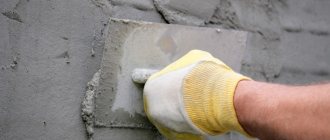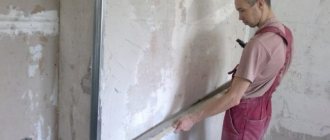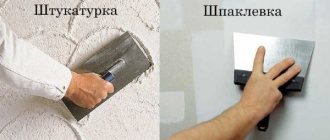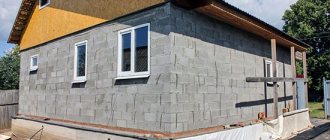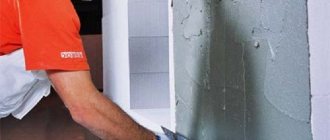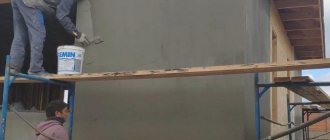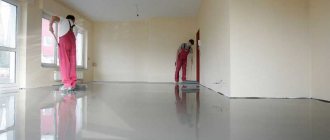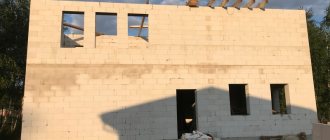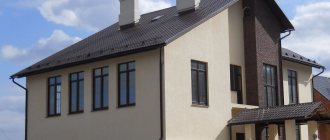- home
- Construction and renovation
- Walls
>
>
⬎
In this publication we will look at plastering walls with gypsum mixtures. We have already talked about the acceptability of using gypsum for interior decoration of residential premises and bathrooms, so here we will consider the process itself.
Let's try to consider step by step all the working aspects for a beginner to complete the work. I would like to say right away that this is a rather difficult matter and will require a lot of perseverance.
Characteristics and composition
The name "gypsum plaster" is not entirely accurate. Gypsum is a mineral from the sulfate class. It has a double structure: fibrous - selenite, granular - alabaster. It is from alabaster that the plaster mortar is obtained, which everyone knows as gypsum.
The technological process is not very complicated:
- the mineral is fired at high temperatures for a long time;
- crushed to a powder state - the smaller the particle fraction, the higher the plasticity and better binding properties;
- additives are introduced:
- fillers with granules no more than 1.5 mm - reduce the weight of the solution. For these purposes, the smallest particles of polystyrene foam, foam glass, vermiculite, and perlite are used;
- plasticizers and modifiers - reduce the speed of setting of alabaster (without additives, after 5 minutes the mixture becomes stone) and improve the level of adhesion.
- bleaches - lime (used before), titanium or zinc based white;
- polymer additives - increase the viscosity and strength of dried plaster.
Available for sale in bags of 5, 15, 25 and 30 kg.
Crushed alabaster.
This is the composition of the dry mixture. Water and retarding agents are added to the ready-to-use paste, as a result of which the solution does not harden without access to air. Pasta is sold in plastic buckets.
Technical characteristics depend on the density of the material and the size of the component fractions. Therefore, specific numbers may vary. The main indicators are:
- color - can be white, gray with different shades, pink and beige;
- The proportion of water for mixing is on average 2:1, where 2 is gypsum, 1 is water. But different manufacturers have deviations - from 0.4 l per 1 kg of mixture to 0.6 l / kg. You need to look at the recommendations on the packaging;
- the thickness of the base layer without reinforcement is from 2 to 5 cm (different for each manufacturer);
- compressive strength - 25-40 kg/cm2 (according to GOST 31377-2008 - 2.45 MPa);
- work is allowed at a temperature of - +5-+30oC;
- solution lifetime - 1 hour (according to GOST - 45 minutes for manual laying, 90 - machine);
- complete drying time - 3-7 days (depending on the thickness of the layer);
- composition consumption per 1 mm of layer - 0.8-1.2 kg/m2 (hand laying - 0.85-1.0 kg/m2, machine - 0.75-0.9 kg/m2;
- adhesion force to the base - 0.3 MPa;
- moisture retention without dripping - 90%. Solutions with 95% appeared on sale, which is much better;
- density - 950 kg/m3;
- vapor permeability - 0.11-0.14 mg/ (m*h*Pa);
- shrinkage of the base layer is not allowed.
Types of plaster gypsum mixtures
Plaster compositions with gypsum are varied. They are divided according to several parameters.
All of them are divided by area of application into:
- universal gypsum plasters;
- gypsum plasters for exterior use (new mixtures with special additives used outdoors);
- gypsum plasters for interior work.
According to operating conditions:
- for dry and normal rooms;
- for rooms where the humidity level periodically increases, but not higher than 75% (subject to a waterproofing coating).
By place of use:
- universal (wall and ceiling);
- high-strength (for floor screeds);
- only for walls (vertical surfaces).
By purpose of use:
- Rough for the base layer. The base compositions contain coarse sand, so they can be applied in a thicker layer. This coating can also be used under decorative plaster for interior decoration, for example, Venetian or Moroccan plaster, facing work.
- Finishing or finishing. Filler grain up to 0.63 mm allows you to obtain a smooth (glossy) surface with a minimum layer of 2 mm.
There are also:
- hand applied gypsum plaster;
- SGShS for mechanized plastering of walls.
According to composition (content of main components) they are distinguished:
- dry gypsum plaster mixtures (SGSHS);
- gypsum-polymer SS (dry mixtures), for example, GYPSOPOLIMERtm, (with polymer additives that ensure good adhesion of gypsum to any base);
- gypsum polymer putties;
- gypsum self-leveling SS for screeds;
- lime-gypsum plaster mixtures;
- gypsum putty.
They all have their own areas of application, pros and cons, as well as characteristics.
Pros and cons of gypsum plaster
Gypsum plaster has gained popularity due to its advantages :
- high plasticity - easily applied and stretched in a thin layer onto horizontal and vertical building structures;
- good adhesion to almost all building materials, including concrete, brick, aerated concrete and clay bases;
- formation of a smooth surface after drying - no further processing is required: grouting and sanding with finishing mixtures;
- absence of shrinkage with a plaster layer of up to 3 cm, and, therefore, the entire surface - no microcracks form;
- excellent soundproofing properties - absorbs indoor noise, weakens structural noise;
- prevents heat loss due to the low thermal conductivity coefficient - 0.23-0.3 W/m*K;
- low weight - no serious loads are created on the walls and foundation;
- environmentally friendly - sanitary standards allow use in any room of a house or apartment (children's room, bedroom);
- ability to pass vapor molecules (vapor permeability). Thanks to this, a comfortable microclimate is maintained in the plastered room;
- economical consumption - allows you to completely offset the higher price compared to CPR;
- fast setting - the following stages of the technological process are not delayed;
- short drying period - from 3 to 7 days, which significantly reduces repair time;
- does not serve as a basis for the development of fungi and mold;
- thinner base layer than cement mortars - 2 cm versus 3 cm;
- fire safety - fire-resistant partitions are manufactured.
The list of strengths is impressive. However, the existing disadvantages narrow, however significantly, the scope of application:
- afraid of moisture - cannot be used outside (on facades) and in rooms with high humidity (basement, bathroom, open balcony or loggia, etc.);
- having an acidic environment, it corrodes metal, even galvanized;
- has low surface hardness - can easily chip or leave a deep scratch;
- Quick setting for beginners in plastering creates problems: they do not have time to work out the batch. But this is the other side of the coin, because... for professionals this is an undoubted advantage;
- Do not work in unheated rooms in winter. Only at positive temperatures - from +5oC or more.
Types of gypsum solutions
Gypsum mixtures are distinguished by their environmental friendliness , excellent quality characteristics and high performance indicators. They differ in the content and quantity of polymer components included in the mixture.
- Solutions containing special polymer fillers that help increase the quality of noise and sound insulation in rooms are suitable only for treating interior surfaces of rooms. Such gypsum mixtures can include completely different fillers, for example, perlite, fine foam, vermiculite and other components.
- Budget options for gypsum plasters contain a minimum amount of polymer components. Therefore, such solutions have a lower degree of adhesion and require additional priming at the beginning of their use. To treat walls, it is necessary to apply several layers of plaster, as well as the creation of special grooves on each of them to increase a better connection with the surface being treated.
- If you take plaster mixtures for treating the surface of walls using the machine method, they are distinguished by an excellent degree of ductility. Moreover, if you apply the solution on the plane manually, the plasticity of the solution will be much worse.
- The highest quality and most expensive options for gypsum mortars for plastering premises contain a large number of different polymer components. Thanks to this, the plastering process is much easier and faster. Such mixtures have a high degree of adhesion and adhesion to the surface. Ideal for interior renovation work.
Before buying a gypsum mixture, please note that it is applied only to concrete, gypsum, aerated concrete and foam concrete surfaces. It is important that the surface on which the composition will be applied is not subject to deformation under the influence of moisture.
Application area
Alabaster-based plaster was originally intended for plastering walls and ceilings inside residential premises made of any materials: concrete, brick, aerated concrete, plasterboard, etc. under wallpaper and paint. Later, they began to putty on slopes, use it to seal seams between sheets of drywall, and with the advent of fiberglass reinforcement, to strengthen the joints of concrete ceilings.
You cannot plaster metal, facades, walls and ceilings in damp and damp areas. There are two reasons:
- acidic environment corrodes metal structures;
- At high humidity, gypsum plaster actively absorbs water vapor, softens and floats or collapses.
But there are exceptions here too. So, gypsum plaster is used under tiles in the bathroom, but not under wallpaper or painting. Gypsum mixtures also appeared for facades. But the amount of polymer additives there is so large that it is not correct to talk about gypsum solutions. These are rather gypsum-polymer plasters.
Mixtures for leveling surfaces
There are several main types of plaster , which differ not only in their composition, but also in their intended purpose.
- The usual mixture is designed to protect walls from the negative influence of external factors, level the surface and eliminate minor defects. After using ordinary plaster, it is customary to apply a decorative coating to the walls.
- As for the special type of plaster, it is intended exclusively to provide thermal and sound insulation of rooms and premises. The composition is capable of covering surfaces with a special shielding layer, which can protect walls from negative effects, for example, from X-ray radiation.
- But decorative plaster is intended precisely to give the walls of the room a completed appearance. It is applied at the very end onto ordinary plaster, as a result of which the walls are light, even and smooth.
To level surfaces and eliminate defects (potholes, cracks, etc.) in residential premises, ordinary gypsum plaster is used , which is available on the market in a large assortment.
Types of gypsum plaster
The criteria for classifying plaster by type are:
- size of component fractions;
- method of application;
- appointment;
- release form;
- color.
Fraction size
When doing plastering work with your own hands, it is important to select the correct mixture according to the particle size of the components. After all, the purpose of the solution depends on the fraction:
- coarse-grained - intended for thick layers of plaster (5-8 cm) when eliminating large surface defects. Difficult to find on sale. You definitely need a reinforcing mesh - without it it will shrink and crack;
- medium-grained is the most popular type of dry mortar. Used to level small differences in height, up to 3 cm. The maximum possible layer thickness is 5 cm, but from individual manufacturers;
- fine-grained - applied with a thickness of no more than 8 mm onto existing layers of previous types. With a thicker layer, extensive cracking is possible. Can be used for putty for painting.
Application method
You can plaster walls in different ways:
- manual - used in small areas or when performing work independently;
- machine - the solution is quickly applied to the walls. The quality of the dried surface is almost perfect. However, to mechanize the process of leveling walls, a stirring station and a pneumatic blower are needed. The equipment is expensive, which is why the prices are high. They can be reduced to an acceptable level only by increasing the volume of work.
Purpose
According to their intended purpose, solutions can be:
- starting ones - applied directly to the walls, hiding defects;
- finishing - laid on an existing layer of plaster. The only function is to make the surface smooth to a mirror shine;
- universal - can be used for any purpose.
Attention: finishing solutions can be applied to drywall without an underlying layer of coarse or medium-grained mixtures.
Release form
Gypsum solutions are offered for sale in the form of:
- dry mixes - sold in bags;
Dry mixture.
- pastes - ready-to-use solution. Packaged in plastic buckets. Weight can be from 1 to 18 kg.
Paste.
Color
Gypsum plaster is associated with the color white. However, you can find dry mixtures on sale:
- white;
- gray, with different shades;
- beige;
- pink.
Colored gypsum mixture.
Gypsum plasticizers
Plasticizers are substances that regulate the crystallization processes of gypsum with different chemical bases. They are added for:
- increasing the strength of the solution (by reducing the water absorbed by gypsum; the harder the gypsum is, the less water is used);
- increased fluidity;
- ensuring waterproofing and good shrinkage;
- reducing the freezing point of water;
- acceleration of hardening in cool conditions;
- increasing adhesiveness;
- increasing air permeability and water resistance.
The concentration of the plasticizer can regulate the setting time.
Some of the popular brands are: Fluid Premia 325, Vianplast, Sika ViscoCrete-G2, Friplast.
Concrete plasticizers are not suitable for gypsum. Unlike white (for gypsum), they have different colors (brown, yellow, gray).
Recommendations for selection
The quality of repair depends on the materials. When choosing gypsum plaster, you must first pay attention to the technical characteristics . They must comply with GOST (given at the beginning of the article). If there are deviations, and they occur in imported products, you need to analyze what consequences this will lead to.
For example, with a manual application of plaster consumption of 12 kg/m2 per 1 cm layer, the cost of finishing increases sharply. In this case, you need to look at the price and the presence of unique properties - the low cost compensates for the overexpenditure, and moisture resistance or high strength will allow you to plaster the walls in the bathroom or kitchen.
The second indicator that you should pay attention to is the date of manufacture . As a rule, the shelf life of mixtures is 6 months. After it expires, problems arise with stirring - many lumps form inside the bag, which are difficult to dissolve. True, the quality characteristics remain virtually unchanged.
The container must be undamaged - gypsum actively absorbs moisture from the air. The result is lumps that practically do not grind. It is better not to buy such dry plaster. Two more important indicators:
- drying time. Varies from 3 to 7 days. More flexible solutions dry faster;
- viscosity. The more plastic the mass, the more convenient it is to work. But such mixtures also have increased consumption. More consumption means higher repair costs. You need to choose one thing.
For wet rooms you need to buy moisture-resistant brands of gypsum plaster. But for financial reasons, it is better to use a well-tested technology - cement-sand mortar for interior work.
If you want to reduce the cost of materials, you can buy alabaster (sometimes they write gypsum on the packaging, which is the same thing). Rapid setting can be eliminated using diluted PVA glue (1% of the solution volume), slaked lime, citric or tartaric acid, or even better by adding the retarder “Plast Retard PE”. In any case, it will be cheaper than dry mixture or paste.
And, of course, look at the manufacturer - for time-tested brands, all the strengths and weaknesses can be found on various forums. Here, buying a “pig in a poke” is excluded.
Storage conditions
SGHS have an expiration date. Usually this is 6 months, after which the structure of the SS deteriorates (for Vetonit LR+ the shelf life is 1 year). This happens even when the correct storage conditions are created, which are as follows:
- storage in undamaged manufacturer's packaging (partially protects from moisture);
- The storage room is dry, the air humidity is no more than ???
- compliance with the temperature regime, to which some additives are especially sensitive (there should be no sharp fluctuations and subzero temperatures, since SGHS freeze);
- Kraft bags with mixtures are stored on wooden pallets.
If the age of the SGHS is greater than the expiration date, then it can be used. Make a test batch and determine which characteristics of the mixture have changed. For example, setting time has been reduced. In this case, the batches are made in a smaller volume and used either as a starting solution, or where the strength of the coating is not so important. When setting time decreases, SS can be diluted with water with the addition of ½-1 cup of PVA (or wallpaper glue) per bucket of water.
Gypsum behaves like cement. Its shelf life is ~6 months.
The article provides answers to questions about how to apply, how to level and how to trowel plaster, whether it needs to be primed and many others. Plastering walls with gypsum plaster with your own hands is quite an exciting activity, requiring ingenuity, mobility and observation. In return - the daily pleasure of realizing oneself as a creator, contemplating smooth walls and living in a favorable microclimate.
Popular manufacturers
Many companies produce gypsum plaster. But in terms of popularity, not a single product can compare “Knauf” Rotband (“Knauf” Rotband) Indeed, high plasticity, an easy-to-work consistency, which is why the mortar adheres well and adheres well, the absence of shrinkage and, as a result, a surface without cracks after drying, are liked by builders.
But there is one big drawback: the price is greatly inflated. At the same time, not due to the best quality and operational characteristics - they are approximately the same for all leading ones, “DeLuxe”, “Unis”, “Ceresit”, etc.), but due to the promoted brand.
Among the competitors, there are several companies that are really good in terms of product quality.
"Volma". The Russian manufacturer supplies the following line of mixtures to the retail chain:
- “Layer”, “Plast”, “Canvas” - for classic manual application;
- "Gypsum asset" - for mechanized.
The product is intended for leveling walls, restoration and decorative work. Peculiarities:
- low price;
- good adhesion to all types of wall materials;
- insufficiently high ductility;
- does not like significant changes in temperature and humidity;
- maximum thickness of one layer - 3 cm;
- no shrinkage during drying;
- does not peel off or crack;
- the color is not only white, but also beige or pink;
- It sets faster than the stated 45 minutes, which creates problems, especially for home craftsmen.
The company guarantees high performance characteristics of the plaster with a layer thickness of up to 5 cm, but subject to reinforcement with fiberglass or basalt mesh.
"Prospectors". Another domestic manufacturer. Supplies mixtures for interior work to the building materials market. They can be used for finishing walls and ceilings, sealing seams and joints, and restoring stucco.
There are no complaints about product quality. It is plastic, fits well, and glosses easily. Plus, the maximum permissible thickness of the base layer is large - up to 5 cm. The disadvantage lies in the area of logistics - packaging in bags of 15 and 30 kg, which is not always profitable.
"Unis". The Russian one has several enterprises in the country. It produces products with the following technical and operational parameters:
- White color;
- diluted in a ratio of 0.4-0.5 l / kg;
- base layer thickness - 5-50 mm;
- compressive strength - 2.45 MPa;
- plasticity is maintained at temperatures from +5 to +30°C;
- the life activity of the solution is 50 minutes;
- consumption per 1 cm of layer - 8-9 kg/m2.
Reviews vary widely in quality. At some enterprises, control over compliance with the technological process has been established. As a result, there are no complaints. At the same time, where this point is missed, shortcomings are noted:
- does not mix well - lumps remain;
- slides off the walls, despite experiments with the amount of water;
- takes a long time to dry.
Can be applied manually or by machine.
"Ceresit". The German company, under the trademark “Ceresit”, produces in the Urals (Chelyabinsk) not only gypsum plaster, but also gypsum-polymer plaster for facade work.
The plaster mixture is impact-resistant, plastic, with an optimal consistency, which allows you to apply different patterns using rollers - imitation of some types of decorative plaster. The disadvantage is the price. Too high. But you have to pay for quality and brand.
"Deluxe" Plaster mortars are not inferior in quality and technical characteristics to German manufacturers, but at a lower price.
"Bolars." The product is used for leveling walls and ceilings. It has:
- color - white or gray;
- compressive strength – 2.45 MPa;
- consumption for a layer 1 cm thick - 10 kg/m2;
- solution lifetime - 60 minutes.
Mixes easily. Lay in a layer of 2 to 30 mm. If the solution thickens ahead of time, you need to re-stir without adding water. Among the disadvantages, consumers note the high price - the most expensive plaster among domestic manufacturers.
Drying the walls and further finishing
It is recommended to dry the walls well before further finishing. At a minimum, you need to wait for visual dryness, when there are no damp spots on the surface. When applying waterproofing, I strongly recommend waiting until the walls are completely dry! You can check this by drilling a small hole in the thickest part of the plaster.
Although, for example, fugen gypsum putty can be applied to a wet surface. It is better not to prime a surface that has not dried out - drying will be slower.
If laying tiles is planned, the surface must dry out. When using polymer putties, it is also better to wait until there are no damp spots left on the surface.
By the way, some manufacturers of plaster mixtures prohibit artificially drying walls with heat fans and guns. Personally, I have not observed the negative consequences of such drying, but in principle I cannot exclude them. Most likely, the manufacturer is afraid of excessive temperatures and humidity in a small enclosed space. Therefore, if you dry it, do it carefully and without fanaticism!
Materials and tools
To work with gypsum dry plasters you need to have:
- dry mixture;
- primer;
- reinforcing mesh made of fiberglass, basalt or plastic;
- metal profile for beacons;
- self-tapping screws;
- special clamps for attaching beacons: “Kremmer”, “Ushastik” or clips. What they are and how to use them can be found here.
Tools and equipment needed:
- stepladder or strong table;
- container for mixing the solution - a 10 or 12 liter bucket;
- electric drill or powerful screwdriver with different attachments (mixer, drill and cross-shaped bit);
- grinder or metal scissors;
- trowel (trowel) for applying mortar to the wall;
- h-shaped rule - for leveling and redistributing the solution;
H-shape rule.
- trapezoidal rule for pruning;
- spatula, even better two: wide and narrow. The first is used for polishing the solution and instead of the falcon, the solution is collected, the second is for processing hard-to-reach places;
- primer cuvette;
- roller or mat - walls are primed;
- sponge grater for polishing the surface. You can take P400 sandpaper and wrap the block;
- laser level or building level;
- roulette;
- plumb line;
- fishing line or twine for hanging walls;
- simple pencil.
How is cement plaster applied to ordinary brick?
The working solution, adjusted to a paste-like state, is thrown onto the wall in the gap between adjacent beacons. The thin side of the instrument is applied to the wall and moved from bottom to top, slightly moving it from side to side. It is necessary to ensure that the edges of the rule do not protrude beyond the beacons. When you reach the top, look where the depressions are and fill them with mortar, follow the rule. Plaster the entire wall in the same way.
Advice: when choosing which plaster is best for plastering brick walls on the outside, give preference to products from well-known manufacturers, such as Knauf
When the surface is plastered, it needs to be rubbed down. Use a foam, polyurethane or wooden grater. Which is better? Foam plastic is short-lived, and wooden, although for a long time it was the only option, is quickly sanded, erased and rounded at the corners. Polyurethane is not erased as quickly as foam: a grater is enough for about 40-60 square meters. m.
Calculation of plaster consumption
The consumption of gypsum plaster per 1 m2 is influenced by several factors:
- curvature of the walls - the greater the slope or height difference, the thicker the layer of plaster is needed;
- type of mixture - grinding depth and consistency affect technological consumption rates. Indicated on the packaging;
- manufacturer - the plasticity of the solution depends on the additives added. But this is a double-edged sword: convenient application equals increased consumption, for which you have to pay.
Master plasterers use several calculation methods to calculate the amount of dry mixture. More accurate results can be obtained after installing the beacons. To do this, design points are marked vertically and horizontally at equal distances from each other on the wall surface. Experts call them key. The more there are, the more accurately the required volume of the mixture is determined.
Then, at each point, the distance from the wall to the conditional plane, which is formed by the beacons, is measured. The resulting numbers are added and divided by the number of measurements. The result is an average layer thickness. Then everything is simpler. The area of the surface to be plastered is found (window and door openings are subtracted from the area of the wall), the consumption rate is taken and the amount of dry plaster in kg is calculated. The formula looks like:
V = S x T x N x k , where:
- V is the volume of dry gypsum mixture, kg;
- S—wall area for plastering, m2;
- T—thickness of the plaster layer, cm;
- N—consumption rate for a layer of plaster 1 cm thick, kg/m2;
- k is the coefficient of unaccounted losses. For professionals it is around 5%; home craftsmen need to target an overrun of around 10-15%.
The procedure ends with determining the number of bags. To do this, the result obtained when calculating using the formula is divided by the weight of the bag and rounded up.
How to plaster a brick wall outside
For plastering external walls, almost the same stages of work that are carried out indoors are applicable.
Using primer, beacons and mesh. The tools are also almost the same. The difficulty is that the cement mortar shrinks and, after drying, produces a fine network of cracks.
What mixtures are best to use?
Brick street walls are plastered with cement mortar and sand. Gypsum mixtures are not used because they absorb moisture, are unstable to sudden temperature changes, and do not “like” direct sunlight and low temperatures.
There are also ready-made cement-based plaster mortars. They can be found on the construction market.
Stages of work sequentially
To plaster walls from the street, the work must be done sequentially.
- Preparatory work. The brickwork is cleaned of dust, debris, and unnecessary objects. Moisten with water. After this, you need to coat the wall with a primer.
- Next, the façade mesh is attached. Apply a thin layer of plaster on top of the mesh and leave to dry. Then the beacons are attached.
- Next, apply liquid plaster and straighten it from bottom to top. Leveling the solution between the beacons is carried out according to the rule.
- We must wait until the liquid layer dries completely. Then apply primer again.
- Go over the dried surface with an iron brush for better adhesion.
- Apply the top layer. Level and leave to dry.
- The last step is grouting. Pressing the grater against the wall, make circular movements along the wall counterclockwise, thereby removing small pebbles and protrusions.
Before plastering the facade walls, it is necessary to carry out preparatory work.
Preparatory work
You need to start leveling the walls by preparing the surface for applying plaster. During the work, the following tasks are solved:
- the strength of the walls increases;
- the level of moisture absorption from the solution by wall materials is reduced;
- adhesion between the base and plaster improves.
The process consists of several independent stages:
- wall repair;
- applying primer;
- installation of beacons;
- mixing the solution.
Repair
At the first stage of preparatory work, the strength of the plastered surfaces is restored. For this:
- Electrical wiring, wall lights, sockets, switches, etc. are removed from the wall. The surface must be cleared of anything that interferes with further work;
- The furniture is moved to the center of the room. If necessary, covered with plastic film;
- old finishing is removed;
- if there is a large area of “bubbling” plaster, it will be completely knocked off;
- cracks, chips, cracks are repaired;
- Contaminants are removed: dust, dirt, greasy heels, traces of paint.
Unfortunately, the length of the article does not allow us to consider this stage of preparatory work in more detail. You can find out more details in the material “How to prepare walls for plaster?”
Primer
Concrete and brick walls actively take water away from any solutions, disturbing the water balance. There is no need to explain what this leads to. Therefore, surface waterproofing is necessary. This can be done using a primer, which not only prevents unauthorized removal of moisture, but also improves the adhesion of the solution to the base.
You need to prime it 2 times, and preferably aerated concrete three times. The next layer is applied to the completely dry previous one. On a flat surface, 1-6 hours are enough for complete drying, on a porous surface - 6-12 hours.
For all types of concrete, it is recommended to use “Betonokontakt”; for other surfaces, other types of primer: acrylic or styrene-acrylate deep penetration primers are cheaper.
Attention: concrete and brick are also primed twice until they are saturated with moisture. But here it is allowed to use a diluted primer for the first layer.
Important! In many works devoted to the problems of gypsum plaster, it is recommended to reinforce the walls after applying the primer. This cannot be done for two reasons:
- Only metal fittings are attached to the wall. But metal and gypsum mortar are incompatible - the reinforcement is corroded by the acidic environment of the plaster within 5-7 years. The option is no longer available;
- Fiberglass mesh is ideal. But it is not attached directly to the surface, but is pressed into the already applied solution and covered with a thin layer of gypsum. More detailed information about reinforcing mesh and fastening methods can be found here.
Reinforcement with fiberglass mesh.
FAQ
- Is it possible to glue wallpaper directly onto gypsum plaster? – To apply wallpaper, the surface of the coating must be primed and, if the surface is grainy, it must be puttied. A glossy white finish will not show through the wallpaper. It is enough to prime it so that the plaster does not draw water out of the wallpaper glue.
- Why does gypsum plaster harden so quickly? – This can happen for several reasons. For example, if you use warm water for a solution, the rate of chemical reactions increases. A sharp acceleration of crystallization causes ready-made crystals formed in the previous batch or even a piece of old gypsum wall plaster to enter the solution. Therefore, it is necessary to thoroughly rinse the tools and wash the containers more often (after each completed batch); you should not throw the solution that has fallen on the floor into the container, etc. Acceleration of setting is also caused by long-term storage of SGHS and storage in opened packaging. SGShS is a counterfeit.
- Do I need to putty the wall after gypsum plaster? – Yes, if it wasn’t shiny.
- Is it possible to lay brick directly on gypsum plaster? - No. For a number of reasons, it cannot be used as masonry. Brick is a porous material, it will draw moisture from the fresh mortar. As a result, the coating does not gain the required strength. And no one will prime every brick.
- Gypsum plaster hardens too quickly, what should I do? – You can mix a small volume of solution with the addition of retarders for testing. If retarders do not help, make smaller batches in order to have time to work them out.
- Is it possible to apply a gypsum plaster screed to a cement screed? - Yes. To do this, the cement surface is primed.
- How to lay a cement plaster screed on existing gypsum plaster? – This cannot be done, since cement is a shrinking material. It will tear the less durable coating.
- How can you make homemade gypsum plaster? – Above are the recipes. However, you need to be prepared for the fact that economically or in terms of time it will not be worth the candle.
- How can you definitely distinguish fake gypsum plaster? – You can distinguish a fake only by directly comparing the behavior of mixtures during dilution and during operation. Therefore, it is easier for non-specialists to be attentive to the packaging details (paint quality, packaging material and other details).
Installation of beacons
Beacons are installed when the thickness of the plaster layer is more than 10 mm. The process is complex. Requires a detailed description of each action. Therefore, we refer everyone who is interested in technology to the relevant material, which can be viewed here.
Lighthouses on mortar piles.
Let us note only one nuance that needs to be taken into account. When reinforcing the solution, the beacons are installed only on self-tapping screws. If you do not plan to use reinforcement, you can use mortar piles.
Mixing the solution
When mixing the solution, you need to follow a few simple rules:
- the mixing container must be clean;
- the mixture is poured into the water, and not vice versa;
- mandatory adherence to the proportions recommended by the manufacturer (available on the packaging). Deviation disrupts ductility, drying time and, as a result, leads to shrinkage with cracking of the surface;
- the plaster removed according to the rule is dumped back into the solution and mixed;
- Before each subsequent batch, the dishes and tools are washed well. Otherwise, the next batch will set faster. Or there may be lumps.
The instructions on how to thin gypsum plaster are simple:
- 1 liter of water at room temperature (20-25oC) is poured into a clean bucket or basin;
- pour out the amount of dry mixture in accordance with the recommendations;
- Using a power tool with a mixing attachment, the solution is kneaded until a homogeneous consistency is obtained for 2-3 minutes. You can stir by hand, which is more difficult and takes longer;
- the solution is infused for 5-7 minutes. Some manufacturers indicate 2-3 minutes;
- mix again until a creamy consistency without lumps is obtained.
The readiness is checked with a trowel - the solution should not drain from the plastering tool. For putty - slowly slide off the trowel tilted at an angle of 45o.
Plaster plaster mortar can be prepared independently from pure gypsum. Several recipes from professionals will help with this.
Recipe No. 1. Take 4 parts of alabaster (gypsum) without additives and mix with sawdust (1 part) and ceramic glue (1 part). All this is thoroughly mixed and then diluted according to the technology described above.
The process takes place in two stages - the solution must mature for 3-4 minutes (it gains strength and plasticity), after which it is stirred again. You can slow down the setting process with PVA glue (1% by weight of the solution) or citric acid (tartaric acid is also allowed, but it is more difficult to find on sale). You need 0.05-0.15% dry citric acid powder by weight of gypsum
Recipe No. 2. Mix 1 part gypsum with 3 parts ground chalk. Add 5% of the resulting mass of wood glue and mix again. Dilution and introduction of retarders, as in the first recipe.
Recipe No. 3. Lime dough is being prepared. Gypsum is mixed in the same proportion, after which the compositions are mixed.
How to dilute the solution
The procedure for preparing gypsum composition is very simple and includes only a few steps. It is important to maintain the necessary proportions here.
- You need to take a deep container, pour in 0.5 to 0.7 liters of water (depending on the desired consistency) and pour in exactly one kilogram of gypsum powder.
- Then the mixture is thoroughly kneaded until smooth. You can mix by hand or using a construction mixer.
- After this, you need to let the mixture sit for a while - five minutes will be enough, then stir again.
It is important to note: the finished solution retains its properties for only half an hour, so during this time it must be completely used. If during this time the mixture is not used and remains, do not try to dilute it again with water and use it for plastering.
How long will it take to dry?
To continue finishing work, you need to know not only how long it takes for gypsum plaster to dry, but also at what speed it gains strength. After all, the finishing touches: gluing and painting can begin after the plaster has completely hardened. This takes from 3 to 7 days, depending on the thickness of the layer. But it’s better not to risk it and start the next stage of repairs in a week. But the applied solution dries within 1-2 days.
The process of strengthening should take place under natural conditions at a temperature of +5-+25°C. No heat guns, heating devices operating nearby, or drafts.
Checking the moisture content of the plaster.
Before subsequent finishing, the room is ventilated and the plaster is primed. The surface ready for wallpaper or paint should be smooth and light. Humidity for wallpaper should not exceed 4-5%, for paint - 1%. Drying up to 10 days may be required to achieve this moisture content.
Use in damp rooms and outdoors
It is a mistaken belief that plaster finishing in toilet rooms is unacceptable. However, toilet rooms are classified as rooms with short-term high humidity. Therefore, GShS is not only possible, but also desirable to use in them. The only condition is that waterproofing is installed in places where there is direct contact with water. In shower rooms, waterproofing is done completely. Waterproofing is selected that is suitable for application to a gypsum base.
A deep penetration primer applied in 3-4 layers is often used as waterproofing.
It was believed that gypsum mortar should not be used to plaster facades where there is constant rain and large temperature changes. New SGShS compositions (gypsum-mineral and gypsum-polymer) are used for outdoor work. Gypsum-polymer compositions are even used for silicate-brick masonry, as well as for a thin layer that levels concrete. Polymer modifiers increase the frost resistance and strength of the coating. In gypsum-mineral compositions, mineral plasticizers are used, which are additional binders.
Recommendations for subsequent finishing
On gypsum plaster it is allowed to glue wallpaper, apply liquid trellises and cement-based decorative solutions, and paint. At the same time, you need to remember that for decorative finishing based on CPR you need to apply a primer twice. Paint can be of different types. But whitewashing with lime mortar is excluded. Even with a primer.
Instead of a conclusion. There are no bad gypsum based plasters. The finishing can be done independently with excellent quality, if you take into account the characteristics of the solution and the nuances of working with it.
Comparison of two materials
So, let's analyze the characteristics of two leveling solutions.
- Cement ones are much stronger than gypsum ones. They are highly waterproof. Therefore, these materials are used for finishing the facades of houses, as well as for leveling surfaces in wet rooms.
- Gypsum compositions are cheaper than cement ones.
- They dry faster, which means the speed of repair increases if you use the gypsum variety.
- The viability of cement plaster is two times greater than that of gypsum plaster. Therefore, the latter is diluted in small batches and everything is done to ensure that it is used for its intended purpose within 1-1.5 hours.
- The plasticity of cement compositions is lower than gypsum.
Craftsmen do not have a dilemma about which plaster is better. They clearly know all the subtleties of the differences. Therefore, experienced craftsmen use cement plaster to level defective walls with serious flaws, and then cover it with a finishing gypsum layer. Of course, priming is required between them. And at the same time, the cement layer must dry well before priming.
Mixtures for manual and machine use
Gypsum plasters are also distinguished by the method of their application. According to this criterion, two types of compositions are classified: for manual and machine application.
Mixtures of the first type are distinguished by a large number of chemical additives, since their main task is to provide optimal time for manual production of the batch. Adding chemicals to the composition allows you to increase the time for the solution to start setting to 40-60 minutes. Thus, in just 4-5 hours a full cycle of work on the external or internal finishing of buildings and premises can be completed.
Gypsum facade plaster - an environmentally friendly coating for a residential building
Gypsum plasters intended for machine application have different tasks. These compositions should have a longer setting period (from 1.5 to 2 hours), since the master needs to process a significant amount of surfaces during this time. The work is carried out in two stages: applying a plaster mixture to the wall with a special gun and leveling this layer. The long period of setting of the composition ensures that the master will have time to complete the full cycle of tasks required by the technology.
Plastering walls by machine
Mechanical plaster
The gypsum composition is fed into the gun through hoses connected to a specialized machine for preparing wet plaster from a dry mixture. For better mixing and to ensure unimpeded passage of the solution through the hose system, fractionated sand (crushed to particles of a certain cross-section) is added to the mixture.

